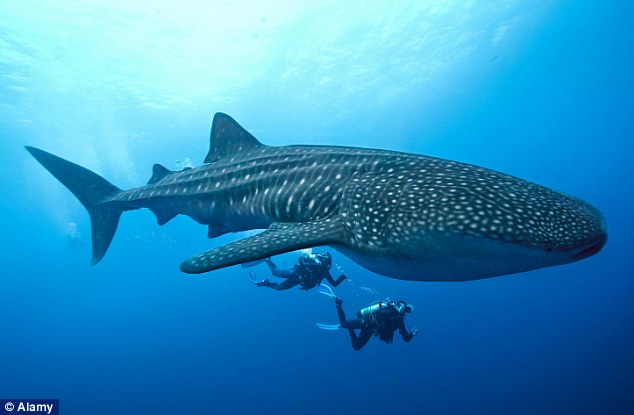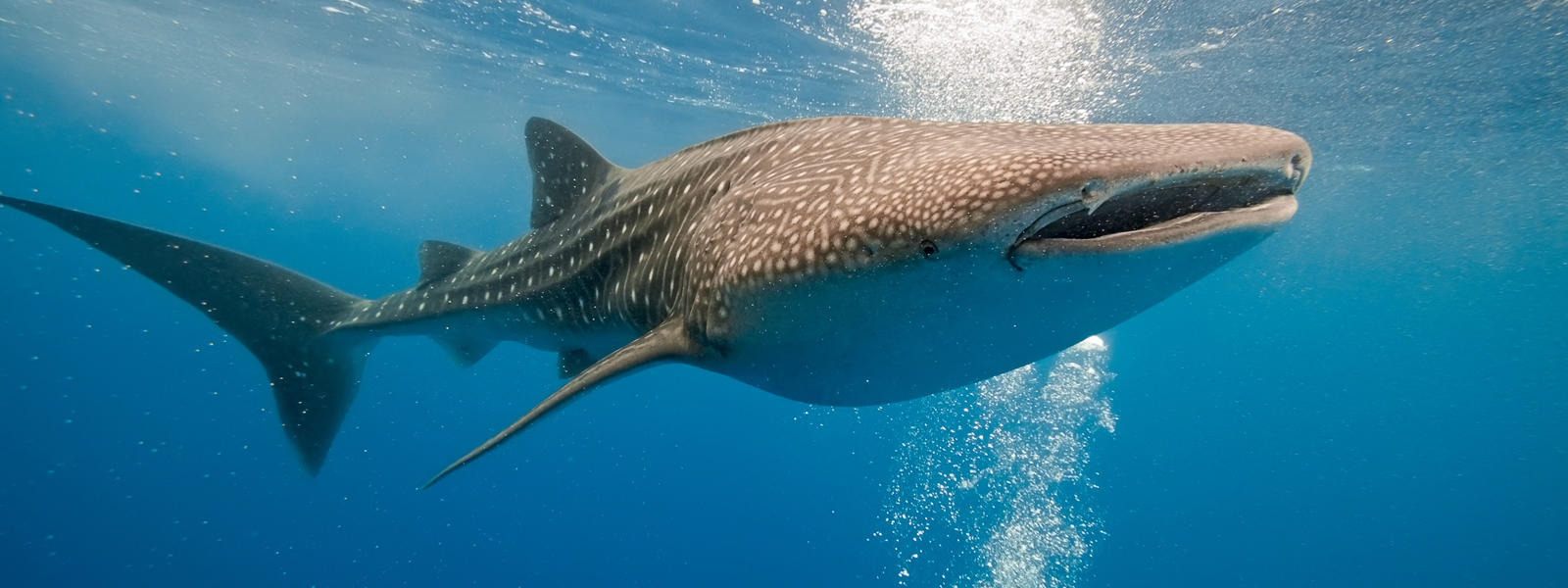
The whale shark, Rhincodon typus, is the largest
extant species of fish in the world and may attain
lengths in excess of twelve meters (forty feet).
Despite its very large size, the whale shark is a
generally placid and inoffensive creature that
feeds upon plankton, swimming crustaceans, and
small species of schooling fish in the water. The
whale shark is a filter feeder, and it cruises
through the water column with its mouth open.
Any food in the water is caught by the large and
extensive gill rakers, which are large, sievelike
structures located upon the gill arches. The water
then passes to the exterior of the animal through
the gill arches, and the trapped food is swallowed.
The whale shark occasionally exhibits more specialized
feeding behavior, hanging almost vertically
in the water and opening its mouth. The
powerful suction caused by the opening of the
mouth draws in water and any food in the vicinity.
Whale sharks are believed to be highly migratory,
and are encountered either singly or in
groups of up to several hundred individuals. Although
comparatively little is known about the
lives of these animals, they have been observed to
congregate at various locations, such as Ningaloo
Reef inWestern Australia, at predictable seasonal
times. These aggregations are believed to be associated
with particularly favorable feeding conditions,
such as the spawning cycles of corals. When
they are not congregating at these sites, whale
sharks are known to make long voyages. Satellite
tracking of radio tags attached to whale sharks for
periods as long as thirteen months have demonstrated
that these fish may range far and wide,
crossing the oceans.
Reproductive and Life Cycles
Although a few young whale sharks have been
maintained in captivity for short intervals, much
remains to be learned about their biology, including
their reproductive cycles. As in all sharks and
rays, fertilization is internal. The males possess
pelvic fins that are modified to form claspers,
which are long, cylindrical structures. These are
inserted into the female reproductive tract to release
sperm, which fertilize the eggs of the female.
Whale sharks were once believed to
be an oviparous (egg-laying) species,
but more recent evidence has demonstrated
that they are ovoviviparous.
In this style of reproduction, the fertilized
eggs are maintained within
the female’s uterus both prior to and
after hatching. At about the time that
the yolk of the embryonic egg has
been completely absorbed, the embryos
are released into the water to
fend for themselves. A single pregnant
female was found to have three
hundred embryos contained within
the uterus, ranging in size from fortytwo
to sixty-four centimeters (sixteen
to twenty-six inches) in length. The
length of the gestation period is unknown.
The life span of whale sharks is not
known, and because of its immense
size it is believed to have few natural
enemies upon achieving adulthood.
A recent report, however, has described
a fatal attack on a whale shark
by killer whales (orcas) in the Gulf of
California, so these latter must be considered
as whale shark predators. Humansmaypose
a threat to these gentle
giants as well; small harpoon fisheries
that fish for whale sharks exist in
some Pacific cultures, including the
Philippines.
Whale Shark Facts
Classification:
Kingdom: Animalia
Subkingdom: Bilateria
Phylum: Chordata
Subphylum: Vertebrata
Superclass: Gnathostomata
Class: Chondrichthyes
Subclass: Elasmobranchii (sharks, skates, and rays)
Order: Orectolobiformes (carpet sharks)
Family: Rhincodontidae
Genus and species: Rhincodon typus
Geographical location: Worldwide, generally in warm temperate
and tropical seas except for the Mediterranean,
where it is conspicuously absent
Habitat: Coastal and oceanic
Gestational period: Unknown
Life span: Unknown
Special anatomy: The largest shark species, reaching total
lengths of at least twelve meters (forty feet); broadly blunt
and flattened snout with a very large mouth located almost
at the very tip of the animal and containing many minute
teeth; a small whisker, or barbel, located on the nostrils
above either side of the mouth; eyes located just behind the
mouth, comparatively very small; prominent longitudinal
ridges extending down the length of the body trunk; large
heterocercal tail that is asymmetric (as in all sharks), with
the upper lobe larger than the lower lobe and a prominent
lateral keel located where the tail joins the body trunk; body
coloration characterized by a checkerboard pattern of light
stripes and spots against a dark grayish or brownish background
on the upper surfaces and pale white below
Other popular Animals
Photo Gallery of - Whale Shark








 Animalia Life
Animalia Life